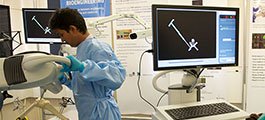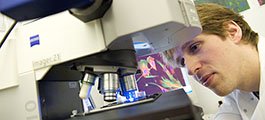We focus on five main areas of research:
- cellular interactions with material/chemicals
- cell & tissue engineering
- hybrid artificial organs
- modelling of artificial organs
- microbial decontamination & sterilisation
Members of staff - Dr Christopher McCormick, Dr Michelle MacLean, Dr Mairi Sandison, Prof Stuart Reid, Prof Will Shu, Dr Melanie Jimenez, Dr Kimia Witte, Dr Junxi Wu
Safety of medical devices has been a focus of much of the work carried out and in recent years we've focused on metal-on-metal (MOM) implants for hip replacement. Work carried out in BME contributed towards the withdrawal of the ASR MoM resurfacing hip implant from the market by the Medicines & Healthcare Products Regulatory Authority (MHRA) in 2010.
Investigations of the in vivo distribution of wear debris and metal ions from MoM implants, and the in vitro effects on osteoblasts, cells of the immune system, and more recently cardiac fibroblasts continues to make a substantial contribution to determining the long-term biological safety of MOM implants, and the mechanisms responsible for their adverse effects in patients. This work has been supported by De Puy International Ltd, and is carried out in collaboration with scientists in the Strathclyde Institute of Pharmacy & Biomedical Sciences (SIPBS) and orthopaedic surgeons based in the Southern General Hospital, Glasgow, and Edinburgh Royal Infirmary.
Safety and metabolic profiling of new candidate pharmaceuticals and recreational drugs has also been investigated with cell systems, particularly hepatocytes, in partnership with SIPBS, Manchester Metropolitan University, and also with GSK. In addition, mechanistic studies on the effects of liver failure on hepatocyte function are being pursued in collaboration with Edinburgh Royal Infirmary. Safety of nanoparticles used as drug delivery vehicles has also been investigated using a new approach which has demonstrated, using AFM, that changes in the mechanical properties of cells may be an early indication of cytotoxicity – projects in this area are in collaboration with SIPBS and CPE.
State-of-the-art equipment
Optimal methods for isolating and culturing hepatocytes are being sought to improve their ability to predict and explain chemical-induced adverse reactions. The importance of the mechanical strength of the scaffold was recognised in controlling the phenotype of these liver cells, and mechanical properties were measured and correlated with cell function. This work has been developed as an inter-research group collaboration internally in BME with essential tissue mechanics input using state-of-the-art BOSE electroforce mechanical testing equipment.
Studies on stem cell differentiation have been actively pursued with Roslin CellLab, and collaboration with Invitrogen/Life Technologies on maintenance of human hepatocytes in different culture configurations is underway with scientists based in USA, and Europe. New scaffolds for liver cell culture have been investigated with industrial collaborators with two companies, Orla Protein Technologies and Reinnervate.
Recent funding boost
Tissue engineering scaffolds are being developed based on collagen for soft tissues, and hydroxyapatite composites for bone. Research aimed at improving the stability of collagen hydrogels for both tissue engineering and cosmetic applications has been underway as a collaborative venture between BME (both Tissue Mechanics and Cell engineering groups) and SIPBS, and has just recently been funded by Medical Research Scotland to develop the field with Collagen Solutions Ltd. Recent work has developed decellularisation techniques for bovine bone tissue, and these natural scaffolds provide an ideal environment for re-populating with human cells to provide transplantable products.
Significant advances
Pulsed Electric Field, originally developed in the University of Strathclyde for sterilising liquids in the food industry, was applied to sterilisation of collagen-based gel matrices. However, significant advances have since been made in understanding the safety of 405 nm light as a method for decontaminating scaffolds, medical devices, and indeed environmental decontamination in orthopaedic operating theatres. This work has been carried out in collaboration with EEE, the Southern General and Golden Jubilee Hospitals.
Hybrid artificial organs
Our research addresses the study of the physical and biological properties of arterial substitutes that incorporate extracellular matrix molecules and vascular cells and the bioreactors in which these tissues are formed and preconditioned in vitro.
An international patent application has been filed for a rotating wall vessel bioreactor and work is underway to improve the licensing position of the technology.
The application of computer-aided design and manufacturing techniques to anatomical modelling, implant design and manufacture is also of major interest to us. In developing arterial phantoms based on medical images generated by MRI and CT we've provided clinicians with the means to determine more accurately the flow structures present within blood vessels in health and disease.
Modelling of artificial organs
Theoretical analysis of fluid dynamics and mass transfer in artificial organs is an important aspect of the design and optimisation process.
Modelling software for fluid dynamics (FLUENT) and for mass transfer (COMSOL Multiphysics) have been applied to the characterisation of blood oxygenators and hybrid artificial liver devices.
Microbial Decontamination & Sterilisation
Microbial infection is a significant healthcare problem, and the development of emerging medical devices and technologies means that there's an urgent need for appropriate sterilisation technologies to ensure device compatibility and safe use.
Work within The Robertson Trust Laboratory for Electronic Sterilisation Technologies (ROLEST) is being conducted into the development and application of a range of novel electrical and optical sterilisation and decontamination technologies for healthcare, public health and environmental applications.
The range of technologies currently under development include visible 405nm violet-blue light, ultraviolet light, pulsed electric fields, and oxidative technologies including ozone, plasma and corona discharges. Investigation into the efficacy of these technologies involves aspects such as microbicidal efficacy testing, mammalian cell toxicity testing, and material compatibility testing.
Current projects are focused on the engineering development and biological assessment of these technologies for a range of areas including environmental decontamination, medical device sterilisation, biocompatibility with mammalian cells and scaffold materials, and surface sterilisation.



